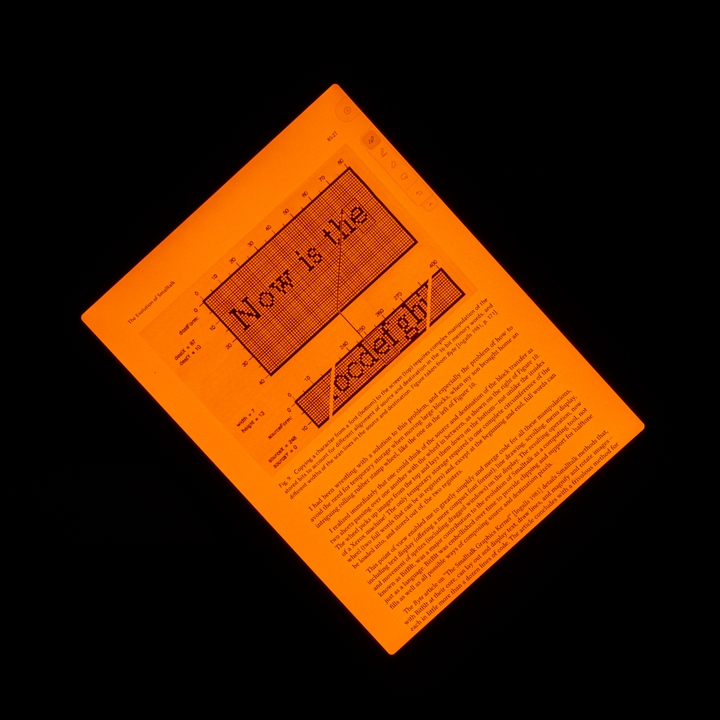
Highlights §
- For the last month, I’ve been testing the Daylight Tablet - a device designed from the ground up to encourage focus, productivity and a more mindful digital existence. It will be available to the public in a few months. (View Highlight)
 (View Highlight)
(View Highlight) (View Highlight)
(View Highlight)- But first, it’s important to understand the evolution of tablets before the Daylight Tablet came along. At the original 2010 iPad launch, the majority of demos were entertainment-focused, with only a brief nod to content creation. Today, the data shows that the majority of time spent on tablets is indeed for entertainment purposes, not productivity. (View Highlight)
- This shift is not entirely surprising when you consider the inherent qualities of the tablet form factor. The iPad’s large, high-resolution display makes it an ideal device for immersive entertainment, rivaling the experience of a television yet remaining portable. Additionally, the dramatic improvements in screen technology, often touted for their benefits to professional users, have equally enhanced the tablet’s appeal as a media consumption device. (View Highlight)
- At the heart of the device is a high-refresh-rate, monochrome, paper-like display that is reflective rather than emissive, mimicking the experience of reading physical paper. This approach reduces eye strain and allows for comfortable use even in direct sunlight. (View Highlight)
- Beyond the display, the Daylight Tablet offers several other features aimed at promoting healthier digital habits. It is completely blue-light free, emitting a warmer, amber-toned backlight in low-light conditions to support better sleep. The device also runs Android apps, providing access to a wide range of productivity and entertainment options. (View Highlight)
- Given that the display is matte and monochrome, the Daylight Tablet encourages reading, writing, and note-taking. (View Highlight)
- The screen discourages entertainment, especially games and video. However entertainment, especially text-based social networking, works fine. So this won’t be a completely distraction-free device like a reMarkable or similar tablet. So there still is the real risk of spending more time than intended on distracting activities. (View Highlight)
- This is where the Daylight Tablet sets itself apart from the reMarkable tablet. Yes, I can read, type on a keyboard, and take notes with a pen, but the Daylight takes me further. (View Highlight)
- Given it runs Android and the display runs at 60hz, I can leverage the productivity apps I already use — Readwise Reader and Obsidian. This seamless integration helps maintain my existing workflow. (View Highlight)
- One downside is that it does not support the Google Play store, which requires color screens. So, alternative stores have be be used. It’s not a deal-breaker, but does add friction to the installation process, a problem absent on other platforms. (View Highlight)
 (View Highlight)
(View Highlight) (View Highlight)
(View Highlight)- While the Daylight Tablet runs Android, allowing me to customize the launcher and multitask if needed, I find the device is best suited for single-app focus. (View Highlight)
- The Daylight Tablet’s paper-like display and lack of blue light emission make it an ideal companion for reading and writing tasks. The lack of blue light does wonders in the evenings when I want to wind down without disrupting my sleep. The reflective screen makes it a fantastic outdoors in direct sunlight, making the Daylight Tablet even more versatile than an LCD or OLED-based device. (View Highlight)
- The Daylight Tablet’s sunlight-readable display makes it well-suited for use in a variety of environments, from my home office to outdoor settings. Its focused functionality means I can use it in situations where I need to minimize distractions and maximize productivity. (View Highlight)
- However, the industrial design and materials lead to a product that feels less durable than either the iPad or reMarkable. I was very careful to use a padded case when carrying it around. This is something that can certainly improve in future versions, but is important to keep in mind if the first production version is similar in design. (View Highlight)
- Consumers are increasingly demanding products that enhance their well-being and support their ability to live, work, and create without constant digital interruptions. The ongoing success of Light Phone and reMarkable are proof that the market is hungry for this revolution. (View Highlight)

 (View Highlight)
(View Highlight) (View Highlight)
(View Highlight) (View Highlight)
(View Highlight) (View Highlight)
(View Highlight)